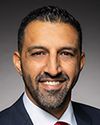I could jump in on behalf of FedDev Ontario.
I'd say it's not so much on the assessment side. Through the indirect investments we make in the ecosystem, or eventually directly to a company as well, a lot of our investment portfolio is very much aimed at positioning southern Ontario-based suppliers to compete and thrive in these global value chains.
One investment we did make last year, in partnership with the APMA, was around the Project Arrow, which was building the first made-in-Canada concept vehicle for EVs. It involved over 40 parts suppliers at the outset, and it's 95% Canadian-sourced.






